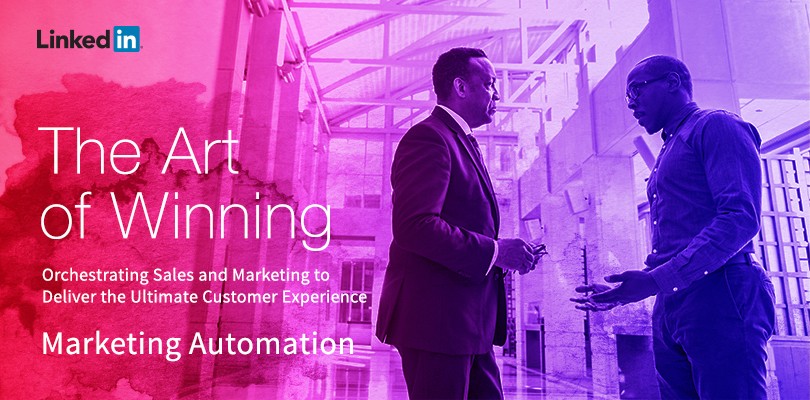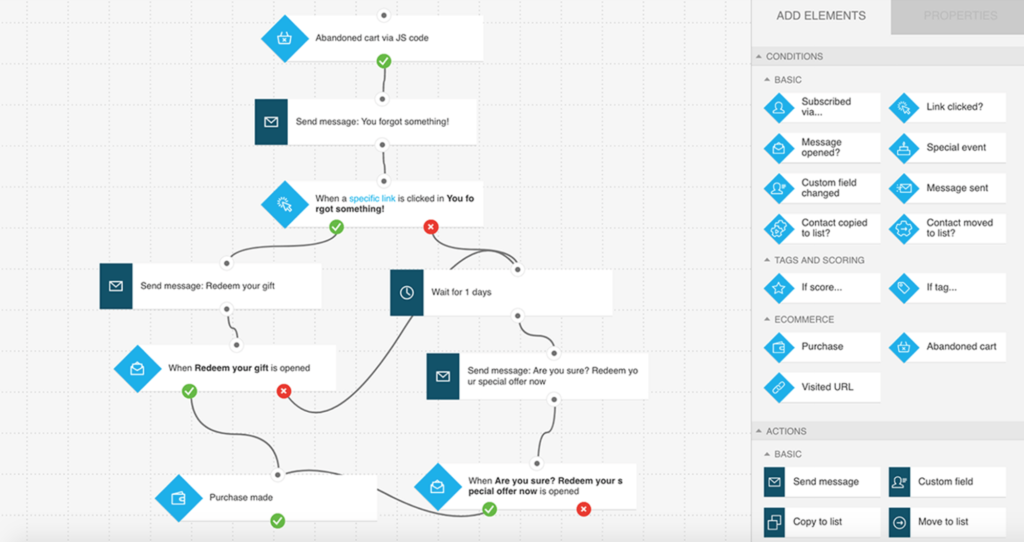What is Marketing Automation & How It Can Help You Win (or Lose) Customers
Are you delivering the experience your buyers expect? According to Accenture:
71% of B2B executives say customers increasingly want B2C-like experiences compared to a few years ago…but nearly half (49%) admit they are failing to deliver the cutting edge and highly relevant experiences customers crave.”
One way to satisfy those cravings is by using marketing automation.
Let’s explore how sales and marketing can use marketing automation to the advantage of both teams...and how to avoid the missteps that sink so many well-intentioned efforts to take advantage of this software.
Why Does Marketing Automation Matter to Sales?
If you’ve ever found yourself frustrated by low-quality leads sent your way by the marketing team, read on. There’s an easy way to solve this problem, but it starts with a little education about the tools your partners across the business aisle are calling upon, namely marketing automation.
It’s crucial for salespeople to understand marketing automation because:
Marketing automation software is responsible for sourcing many of the leads that eventually land on salespeople’s desks.
With an understanding of how marketing automation works, the sales team can better partner with marketing on propensity models and lead scoring. Come together in this way, and you’ll be helping the tool source more qualified leads, the ones with the highest potential of converting down the funnel into customers with a high lifetime value.
A basic understanding provides insights into how sales accepted leads are being nurtured by the marketing team, positioning the sales team to provide meaningful feedback on the nurture process.
Sales and marketing teams are in it together. Marketers are generally responsible for maintaining their marketing automation software, but input from sales is essential to how well they can use this tool. By helping marketing understand the details on buyer personas and behaviors, sales sets up marketing for success - and that’s a win-win scenario.
Read on to find out what exactly marketing automation is and does. Then make time to speak with your marketing team about how you can help evolve your company’s approach to automation.
What is Marketing Automation?
As its name implies, marketing automation is software that automates repetitive marketing tasks and processes associated with nurturing leads, personalizing messages and content, and sending emails, to name a few. Most marketers use it to manage their email campaigns, landing pages, and lead scoring and qualification. They can also use the software to help manage social media and blogging.
Marketers can use the software in all these ways even when they’re out of the office. In other words, the automation keeps working for always-on lead generation and nurturing. That said, marketing automation only enables a company to interact with individuals that have opted in to hear from it.
What marketing automation is not
Since it’s designed to support interactions with individuals who sign up to hear from your marketing team, marketing automation is not purpose-built to support account based marketing (ABM). After all, ABM is focused on a set of target accounts – comprising individuals who may not even be aware of your company.
Marketing automation software is also not something to set and forget. Marketers need to build workflows, craft messages and campaigns, and create templates (or populate existing ones). Once they’ve launched their campaigns, they need to analyze the results and continually tweak their messages, calls to action and offers to drive the best possible outcomes. Together, you might even need to redefine who qualifies as a lead, how to score them, and the process for moving them through the buying cycle.
Who uses marketing automation?
While marketing is the primary user of marketing automation, the software also serves the sales team. Companies can use the software to nurture sales accepted leads and sales qualified leads that are not ready to talk to a sales rep.
How Marketing Automation Works
This software can automatically send templatized campaigns to your audience based on various rules, segmentation, and workflows your marketing team sets up (see image below). The software can automatically segment leads and send personalized messages to the right audience based on the preset rules and each contact’s profile. Marketing automation increases the efficiency of a company’s marketing strategy by allowing marketers to create and re-use certain lead gen tactics, be it a welcome message to subscribers or a nurture campaign after someone downloads a piece of content.
Marketing automation calls upon triggers to determine when it should send messages via email or text, or even display them on a web page. These triggers are determined by known behaviors and information about prospects and customers.
The target audience can provide this data by filling out landing pages and web forms, for example. Marketers can also gather this information based on the actions people take on the company’s website (as captured in cookies), in its apps, in response to emails, on social media, and so on.
Source: https://www.getresponse.com/features/marketing-automation
Supporting inbound and outbound marketing
With marketing automation, marketers can support both their inbound and outbound strategies. Outbound marketing is sometimes referred to as interruption marketing because it describes a company proactively reaching out to try to engage a prospective buyer. A cold sales call, direct mail, TV ads, and display ads fall into this category.
When you do connect with someone via outbound marketing and they agree to hear further from you, they are added to the appropriate marketing automation workflow. In an ideal world, the software automatically sends them the correct emails as part of a predefined campaign.
Marketing automation also serves the right content to prospects and leads who engage with a company via inbound marketing. For instance, say someone arrives at a vendor website after conducting a Google search and then downloads an eBook. Your marketing team might create a flow in their marketing automation software to follow up with another piece of relevant content, now that they have captured the email address of the interested party.
Enabling sales engagement
Once prospects or leads have moved far enough through a campaign, marketing automation can route them to the CRM system for follow-up by sales. Even then, the software can continue to nurture leads with messages and content offers until they are ready to actively engage with a sales rep. The software also measures campaign results so the marketing team can learn what works best and what needs adjusting.
Benefits of Marketing Automation
One of the main benefits of marketing automation is that it automates and streamlines routine tasks. In fact, a recent survey found that marketers cited the top benefit as saving time, followed by better lead generation and driving higher revenues.
Obviously automation on its own doesn’t translate to higher revenues. However, marketing automation helps send timely communications to the right audience, which triggers higher rates of engagement and higher quality leads. Combined, these factors make it possible to drive impressive sales outcomes.
In fact, by more efficiently generating more qualified leads, marketing automation helps drive down cost per lead. Even when used to engage existing customers, the software can boost retention and, in turn, drive additional purchases.
Perhaps most importantly, by helping the marketing team more efficiently deliver higher quality leads to sales using an agreed-upon process, marketing automation helps improve alignment between the two groups.
Marketing Automation Gone Wrong Can Alienate Buyers at Scale
You might wonder why every company using marketing automation isn’t jumping for joy and rolling in the dough. Well, just like any technology, marketing automation only works when applied strategically to a well-defined process.
According to Bill Gates:
The first rule of any technology used in a business is that automation applied to an efficient operation will magnify the efficiency. The second is that automation applied to an inefficient operation will magnify the inefficiency.”
So, if the core buying experience is subpar, automation only serves to amplify an already poor experience. In the process, companies alienate a massive number of prospects and customers.
Highlighting the disconnect between marketing and sales
Consider this all-too-common scenario. A buyer receives an enticing offer to try a new software application for free via a message sent through marketing automation software. She calls in to take advantage of the trial but gets routed to a sales rep who knows nothing about the offer. Instead, the rep suggests a workaround in the form of a trial discount.
The buyer declines and hang ups but is then bombarded with emails and phone calls. Finally fed up, she tells the company to remove her from its list. In spite of this, she receives several more calls, becoming more annoyed with each interaction. Her experience is so outrageous that she freely shares it with colleagues and peers.
The buying experience left a bad taste in her mouth. She will never do business with this company – nor will many of the people who heard about her experience.
Unfortunately, the company was its own worst enemy, messing up a prime opportunity to engage a promising buyer. Ironically, the company’s marketing and sales teams remain clueless to this reality.
The marketing team sees success – the prospect responded to the offer and Marketing got credit for a marketing qualified lead (MQL). Sales made contact with a prospect but decided the buyer wasn’t ready to purchase and threw the lead back into the nurture bucket. More realistically, sales drops the lead and the company is never contacted again or nurtured.
Automation can even scare away existing customers
Here’s another example of automation gone wrong. Someone from SmartBug filled out a form to download an ebook from a vendor’s website, and then received a new sales contract via email. Yet he hadn’t placed an order or spoken to anyone at the vendor’s company. What makes it even worse is that SmartBug was already the vendor’s customer.
What was the fallout? The folks at SmartBug felt that “Clearly we meant very little to this company. They didn’t even recognize us as customers…We started second guessing exactly how comfortable we felt relying on this company for an integral element of our business.”
This type of alienation isn’t solely due to marketing automation per se. It’s usually a combination of problems or oversights. As SmartBug said, “…thanks to one great piece of content, a poorly architected marketing and sales handoff, and a bit of laziness, we were shopping for a new vendor.”
In both cases, it’s no surprise that marketing and sales failed miserably: they didn’t communicate what each was doing to engage the buyer. Sadly, if this happens with one of your buyers, you can bet it’s happening across most – it not all – of them…especially if your company is using marketing automation software to automate inefficient or poorly designed process.
In a world where people expect to be respected as individuals, it doesn’t fly to treat prospects and customers to automated alienation. Companies that don’t evolve may soon find themselves out of business.
Marketing Automation Best Practices
If your company is going to use marketing automation software, you might as well take advantage of all the lessons learned by experienced users.
Figure out what you’re automating
While you can apply marketing automation to many activities, it starts with managing the lead process. So the first order of business is defining that process – or lead stages – from end to end. Work with your marketing counterparts to map out how leads will flow from marketing to sales, and what happens at each stage. The stages might vary, but common ones include Anonymous, Known, Inquiries, Marketing Qualified Lead (MQL), Sales Accepted Lead (SAL), Sales Qualified Lead (SQL), Won, Lost, Recycled, and Disqualified.
Map to buyers and their purchase process
Since your marketing counterparts will be using marketing automation to send emails, messages, and offers to prospective buyers and existing customers, you need to understand what resonates with each buyer type at each stage of the buying cycle. What information do your buyers need and what actions do the marketing and sales teams need to take? They’ll also use the software to engage leads that have been handed over to sales, so will want to get sales’ input on the content and messages that work best with late-stage buyers.
Set up triggers
Because marketing automation is used to automate routine tasks, you need to define what actions it should take and when. While marketers address some of this in the workflows, they also do this by defining triggers.
Perhaps your company sends a follow-up email whenever someone downloads certain content assets. Or say marketing is passing a MQL to sales. They could set up a trigger to update the lead status to MQL, notify sales to follow up, and remove the lead from the current nurture campaign. They could even set a trigger to send an email to contacts that mention your company on a social media channel.
Make short work of lead forms
Lead forms are one of the main ways a company can capture leads using marketing automation. Unfortunately, many buyers are turned off when confronted with requests to fill out lengthy forms in exchange for access to content. Paring back the number of form fields is one way to combat the buyer tendency to abandon lead forms. Another way is by taking advantage of LinkedIn Lead Gen Forms, which pre-populate fields with profile data for LinkedIn members. In addition to drastically reducing the effort needed to fill out forms, LinkedIn Lead Gen Forms are mobile optimized for small screens.
Keep your data clean
Your marketing automation solution helps fill the sales pipeline, effectively nurture prospectives, and pass qualified leads to sales. But it can only do this by calling upon clean, accurate data that enables marketing to deliver the right message to the right person at the right time. Make it a habit to routinely clean up your databases by identifying and merging duplicate leads, removing inactive leads, and standardizing entries in fields like “state” (e.g., “Massachusetts, MA, Mass., Ma., ma, etc.). Most marketing automation software include tools to help. Marketers can even run a campaign to identify and remove leads that haven’t engaged with the company within your typical lead lifecycle time frame.
Take a multichannel approach
Though marketing automation is typically used to run email campaigns, it can also be used to manage communications across channels. Why just send an email when some in your target audience might prefer to hear from your company via text or social media? Using software to communicate with contacts this way at scale boosts the odds of getting a higher number of potential buyers to engage.
Align marketing and sales
It’s a no-brainer that marketers should integrate their marketing automation software with your CRM system. This gives both marketing and sales a more complete view of each prospect and customer. Plus, the integration will enable seamless lead handoff and lead re-nurturing (such as when the sales team decides a sales accepted lead or sales qualified lead needs further nurturing).
Marketing Automation Trends
Now that we’ve explored all the ways your company can and should use marketing automation, let’s see what’s in store. According to Forrester, companies will spend over $25 billion on marketing automation technology by 2023. Between now and then, here are some possible developments when it comes to how companies will use marketing automation.
Introducing the human touch
Even in the B2B world, you’re selling to people, not businesses. One long-standing complaint about marketing automation is that it automates interactions to a fault, leading to cringe-worthy experiences like the ones described above. Out of necessity, more companies will likely start figuring out how to achieve a better blend of automation and human touch.
Getting smarter with AI
AI is already being used to personalize interactions, making it a natural fit with marketing automation. It’s easy to see how AI could determine the best time to send emails to individuals based on each person’s habits and preferences. Similarly, it could send offers by analyzing a site visitor’s search history or a customer’s purchase records. Imagine AI conducting A/B tests to select the best-performing subject lines and calls to action.
Driving better account engagement
Technically, marketing automation was designed to engage individuals rather than members of a buying committee within a target account. It’s not that organizations don’t and can’t use marketing automation to support account based marketing. But the software needs to be integrated with the sales’ team’s system of record (usually CRM) to fully support account-based programs. That said, even today, organizations are beginning to use AI-powered tools that help deliver targeted ads to the right people within the best-fit account.
Automating marketing and sales
A lack of sales and marketing alignment is derailing far too many buying experiences. To that end, more B2B companies are taking steps to get marketing and sales working together. We applaud those efforts. But too many are not addressing the right problem with their spend. Ironically, by pouring money into technologies designed to drive efficiency – think marketing automation, predictive intelligence, sales dialers – companies are inadvertently churning out bad customer experiences at scale.
The good news is that you can take advantage of data and the right technology to enable the sales and marketing alignment that will fix this issue. LinkedIn helps bridge the gap with solutions like LinkedIn Sales Navigator, Account Targeting, Contact Targeting, and Matched Audiences.
For the ultimate resource on how to align your sales and marketing efforts for a seamless customer experience, download The Art of Winning eBook.
Topics: Sales and marketing alignment
Related articles







